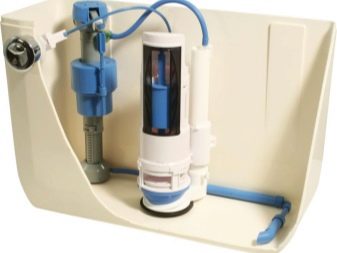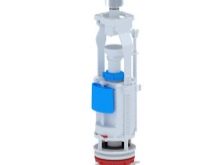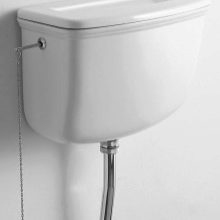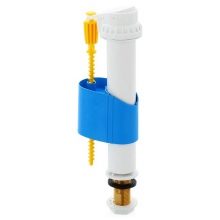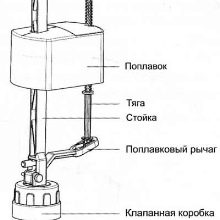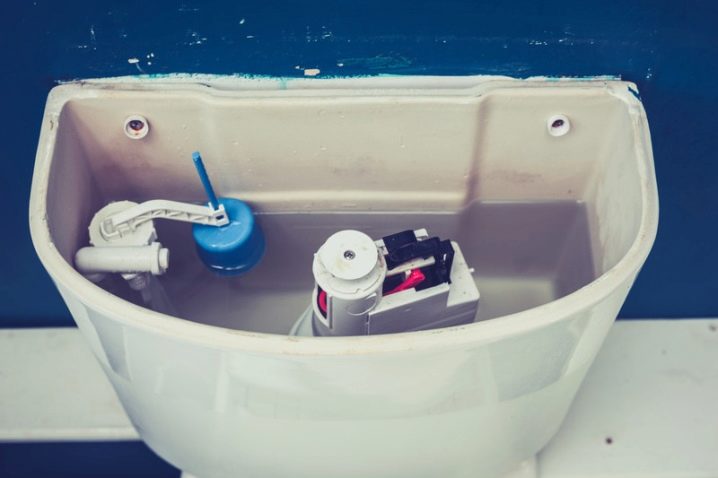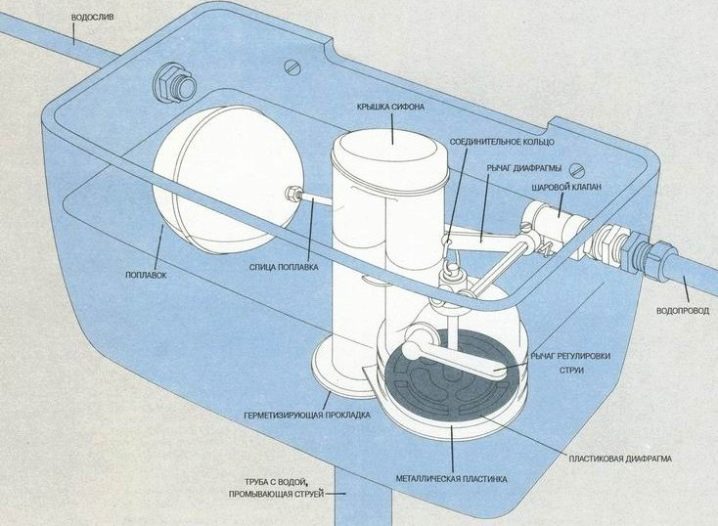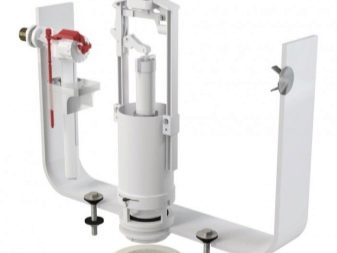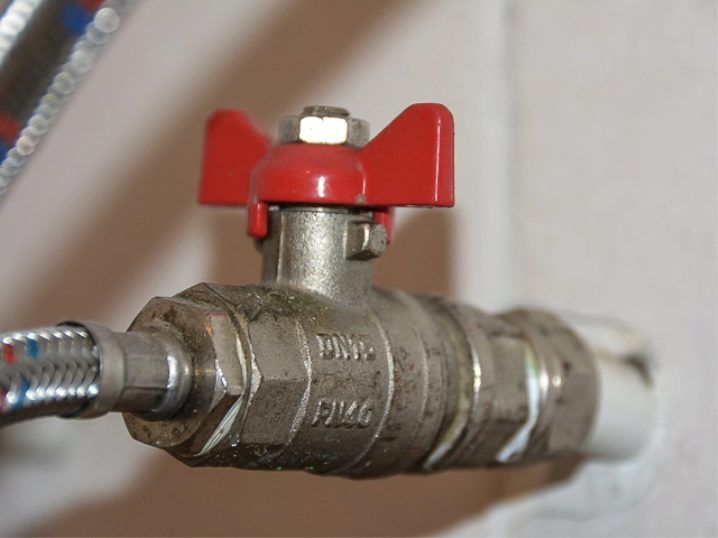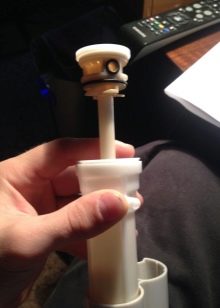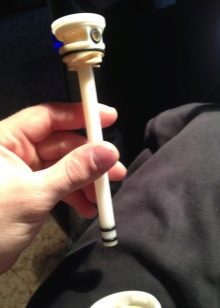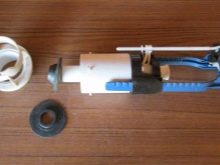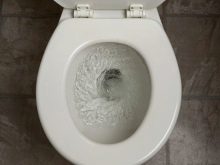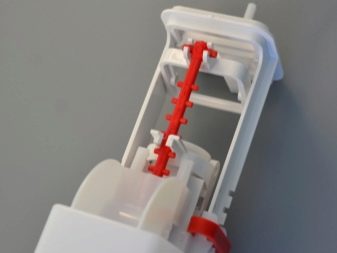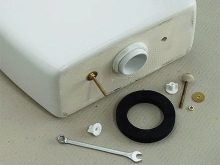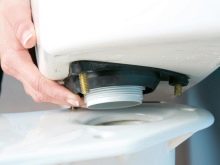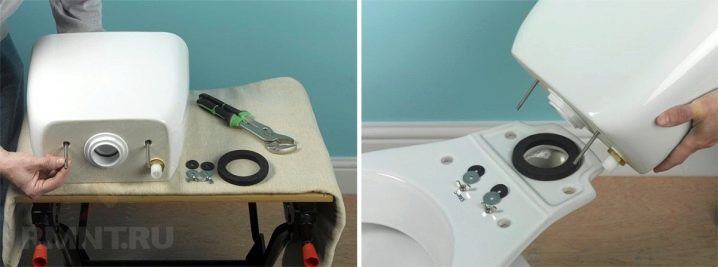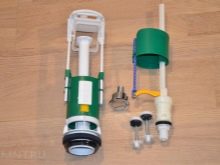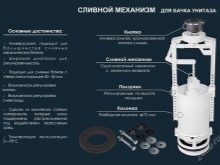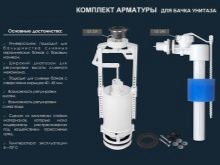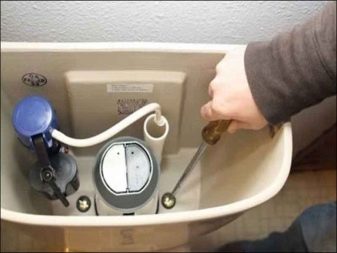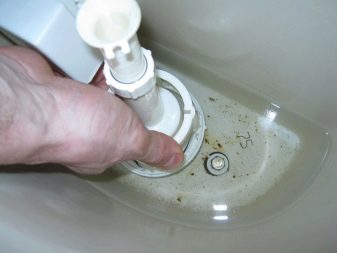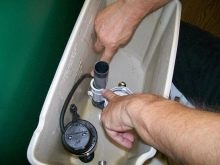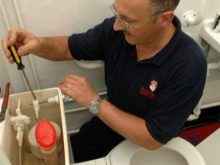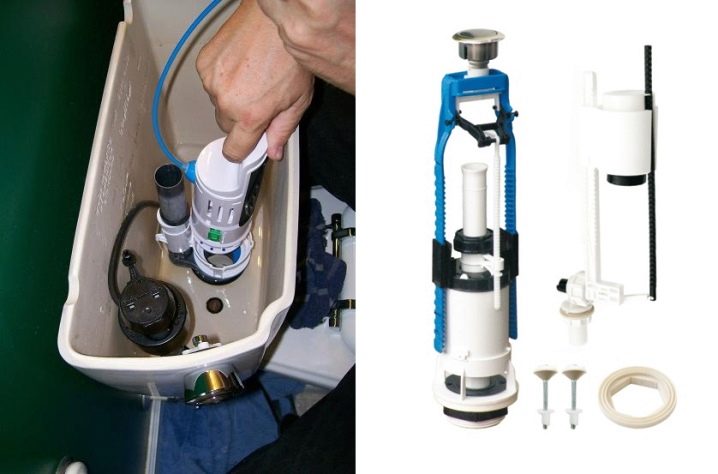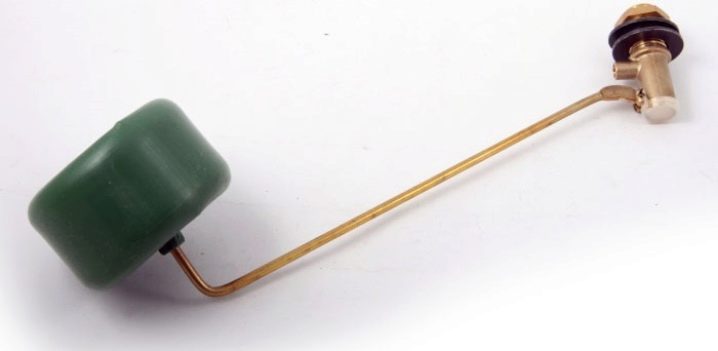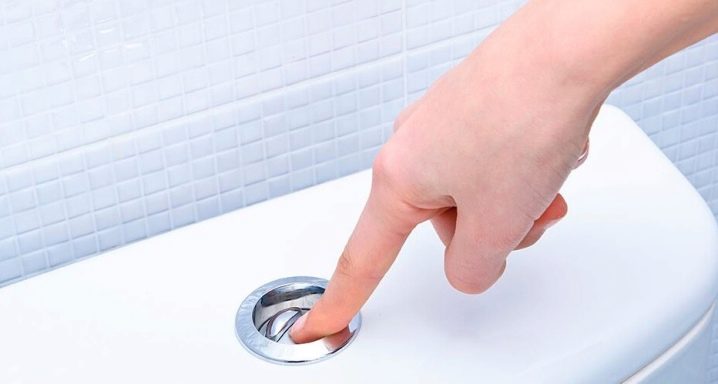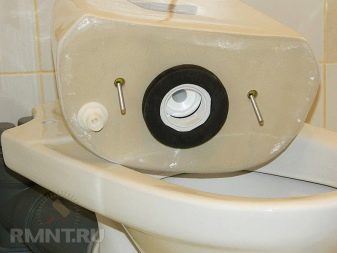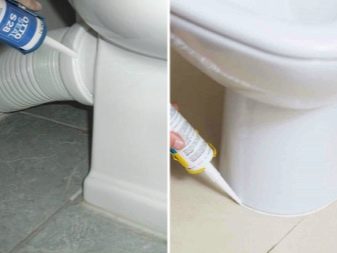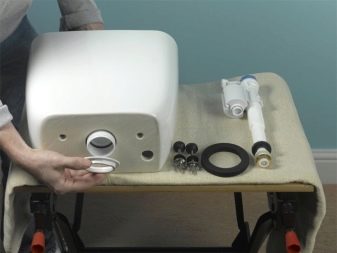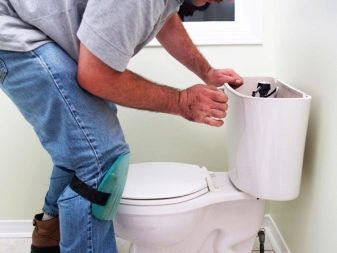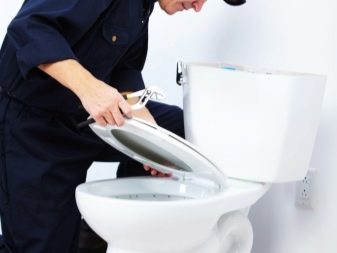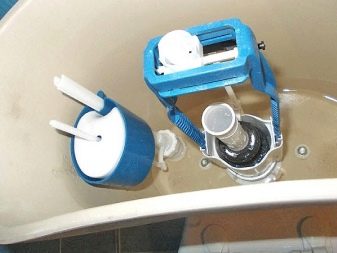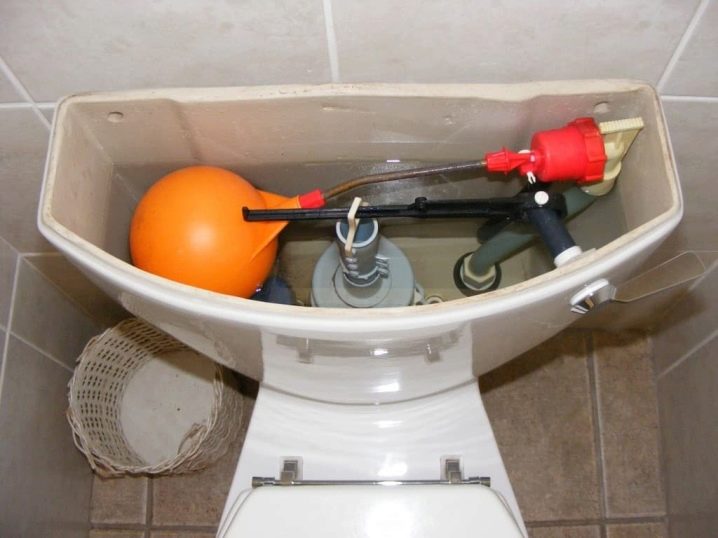Features of the adjustment float for toilet

The toilet seems to be a rather simple device, but only for those who have never been interested in its internal components. In this article we will try to understand the device and the mechanism of discharge in stages and we will study the main problems and faults that may arise during the operation of sanitary equipment.
Types of floats
It is worth noting that the drain tanks over the past few years have undergone many changes. Now they are not close to the “inhabitants” of bathrooms, but coexist quite peacefully next to the toilet. Today in the market of building materials can meet two types of tanks: stationary and hidden.
Their main differences are in three nuances.
- Material. Stationary models are most often made of the same material as the toilet itself. It can be sanitary ware, ceramics, porcelain, natural or artificial stone. Hidden designs are made only from dense plastic.
- Water supply. The first can be arranged both with the bottom and with the side system. Drain tanks in the installation receive water only from the bottom.
- Draining. Tanks installed on the shelf of the toilet and being a whole with it, drain the water with a push-button or rod trigger. Hidden plastic devices have a one- and two-button system.
At the same time, the systems of push-button draining of both tanks differ only in nuances. For example, in stationary containers there is only one button that flushes the toilet down with the first pressure, and stops the flow with the second.
Concealed structures, for this purpose, have two buttons, one of which supplies the liquid at full power, and the other one is almost half as large.
All this is possible thanks to one important detail in the drain mechanism - the float.This detail is called so because of the peculiarities of its design, which always keeps it afloat, like the fishing tackle of the same name.
Toilet floats come in two forms:
- ball;
- "glass".
The first type has recently been used extremely rarely. He remained in those rare models of cisterns, which were under the ceiling of the toilet. To carry out the discharge in such a design, it was necessary, as in a fairy tale, to "pull the string." But it was not the door that opened, but the valve, which released a powerful pressure of water from the tank through the pipe directly into the toilet.
In modern drain constructions, a plastic device called a “glass” is increasingly used. It is a rectangular namesake of kitchen utensils, turned upside down and lowered into the water at a certain level. Such a float can be adjusted using a plastic screw that lowers and raises it to the required height, which determines the level of filling of the drain tank with water.
You also need to understand that this part is part of the complex, which makes the drain work.
Another important design element is the float valve. Their interaction is inextricably linked with each other. Therefore, the failure of one will necessarily entail the abnormal functioning of the other.
Principle of operation
To accurately determine the principle and meaning of the float in the cistern, pay attention to the structure of the whole mechanism. Inside the tank there are three main systems: bulk, drain and overflow. The collection of water in modern models occurs in two possible options: from the side or bottom. Most Russian manufacturers prefer the first option. If you came across a copy of the bottom water intake system, then you are a happy owner of an imported model with a more comfortable and quiet filling process.
The side system is represented by the so-called float valve.consisting of two main parts: a housing with a membrane that blocks the flow of water into the toilet when this is not necessary, and the float itself. The latter is connected to the upper point of the valve body with a special jumper. Therefore, when the water level in the tank changes, and the float rises or falls, the piston closing the hole,also comes into motion. Pay attention to the layout of objects inside the cistern with side filling.
We will understand how the water supply system works from below. The principle is the same as the previous one. There is one small difference, which consists in the fact that the float, as if on a rail, moves along a special plastic rod.
The drain system works in such a way that the central piston connected to the button or lever on the outside of the tank rises, dragging the shut-off valve along with it. This opens the drain hole and the water goes into the bowl of the toilet bowl.
The overflow system has a very important function. Despite this seemingly frightening name, it actually prevents excess water from leaking through the top of the flush tank. Usually this is the upper part of the piston, which is filled with fluid and leads it through the drain hole. This happens in the event that the automatic stop of the dialing for some reason did not occur.
Breakdowns and methods of elimination
Unfortunately, breakdowns are far from uncommon in modern drainage designs. But you will not change the entire tank, if the fault can be fixed and corrected by yourself.To do this, it is necessary to familiarize yourself with the main causes of breakage in the drain tank.
Very often problems arise with the float:
- water intake does not occur;
- constant flow of water on the back wall of the toilet bowl;
- insufficient water to drain.
All this is very easily fixable, even if you do not have sanitary knowledge and experience. To fix the drain tank, which does not take water in general, it is necessary to determine the cause of the breakdown: skewed float, clogged inlet valve, fouling of the float with mucus and bloom. The first reason is eliminated quite simply and quickly. The “culprit” should simply be put in the right position and check to see if he now passes water into the system.
If the toilet bowl is broken for a second reason, you must perform certain actions.
- Turn off the water supply. First of all, you should make sure that the float is the cause of the breakage, and not the water hose. Unscrew it from the tank and turn on the water. Check whether sufficient water flows from it. It is advisable to do this over the bathroom or over the toilet itself, so as not to pour water on the floor.If everything is good here, go to the second step.
- Unscrew the valve and simply clean its connection to the water supply hose. For this, it is best to use a long wire that does not bend during the repair process. At the final stage of cleaning, you can open the water so that it washes away the remnants of pollution.
- The final step involves making a full set and lowering the cistern a couple of times to make sure that the problem is corrected.
The problem with the lack of water supply is solved, you can safely use your drain tank for a long time, until you decide to replace the entire structure as a whole.
In case of breakage associated with poor quality water entering the tank, plaque and mucus often form on the float. These ingredients do not allow it to fully rise and fall, which prevents the natural collection of water from the plumbing. To resolve this problem, remove the float from the rod and rinse it thoroughly under running water. After installing it back, check the water intake process.
A very common phenomenon is now recognized incessant waterfall in the toilet bowl.
This happens for four main reasons:
- the gasket in the valve deformed or fell into disrepair;
- the gasket is not pressed tightly against the outlet of the valve;
- broken stud;
- breakage of the valve itself.
Each problem has its own solution. Start by opening the toilet bowl. If you immediately see from above that water enters the valve through the overflow, try raising the float slightly. Is the flow stopped? Then one simple action will save you from the problem. Twist the float lever to determine its most effective position.
If the float rises and the water still flows, continue your research. The next step is to disassemble the drain valve itself. In its composition there is usually a metal stud, which fixes the lever. It may be damaged. This problem can be solved only by replacing it.
The best option in this case would be a piece of thick copper wire.
After examining the valve itself, make sure that there are no cracks or additional unwanted holes. This also causes the drain tank not to keep water inside. Eliminate the leak will be possible only by replacing the valve itself.
In order to find the right one, you should take the old one with you to the store as a sample.
Pay attention to the gasket located between the bottom of the drain valve and directly to the outlet. Since this spare part is always made of rubber, it is quite likely that it will deform and fit loosely. Because of this, the valve does not completely block the drain hole and the water is constantly leaking. The problem can be solved only by its rubber gasket.
Sometimes the valve itself is still contaminated, which is solved by its timely flushing.
Insufficient or, conversely, an excess amount of liquid during the discharge can be easily adjusted. To do this, you only need to set the level of the float in such a way that water does not get above its position. This is done by manipulating the floating element. Previously, these parts were made of brass, so the position of the float could be corrected by slightly bending the spokes. Today it is mostly plastic. Therefore, the float simply moves along the ratchet with the help of a special screw, which fixes its position.
There are also problems that are not related to the operation of the float, but may be confused with it. For example, when there is a leak between the cistern and the toilet shelf on which it is installed. Many people mistakenly believe that the reason is also a wiped gasket or a faulty valve. However, after cleaning or replacing the last leakage is not eliminated. This is such a common problem caused by prolonged use of the sanitary construction. Bolts that hold the tank to the toilet, could rot. Because of this, a loose fit of the upper part to the lower part and, consequently, a leakage occurs.
The reverse process is observed in the event that installing a plumbing device with your own hands, you re-tightened the same bolts. Then at the exit from the tank into the toilet you will find a very scant stream of water that does not wash away the products of human life. The solution is to loosen the bolts.
If, nevertheless, there is a problem in the drain system and you need to replace the float and valve, the advice of professionals will become a real lifesaver in this matter.
How to choose?
Of course, first of all, you need to find the right valve for the cistern. If you do not pay enough attention to this issue, you can get a leakage of the already new system after at most 7 days after the repair. When choosing a main toilet device, you should be guided by the quality and power of the tap water supplied to you.
Depending on this indicator, float valves are of four types.
- For a weak pressure of water. This look is made using a peculiar amplifier of water supply.
- For water flowing at an average rate and capacity.
- For a pressure of the maximum power.
- Valve stabilizer. If you have an unstable water pressure at home, this device will help to normalize any power of the fluid entering the drain tank and leaving it.
Of course, the amount of water that is always in the drain tank also plays a role in choosing such an important part as the float valve. For example, if you are using a suspension with a double drain button, you'd better choose a piston for an average head. Its capacity is enough to supply a large amount of water to the toilet bowl, as well as a smaller one.
When all the procedures for the selection of the float valve are performed, it is possible to take up an independent installation. How this can be done as quickly and comfortably as we can read.
How to install?
The basic techniques for installing a new valve drain design with a side connection and a button are in step by step instructions.
- Unscrew button counterclockwise. Thanks to her tank cover is attached to its base.
- Remove the tank cover.
- Shut off the water supply.
- Drain all the water that has remained in the drain tank.
- Remove the flexible tube water supply (if the tank is equipped with a side supply, then it will be easier to implement). Use the adjustable wrench.
- Put a new float station.
- Adjust the required water level in the tank.
- Return the water pipe to its place.
- Let the water in the drain tank.
After making all the manipulations on the installation of the float valve, make sure that water is collected in the tank, whether it is leaking or not stopping, if it is not fully reached. Remember one important point: the float in the tank should stand exactly. Distortions can lead to improper functioning of the flushing system and unpleasant impressions of the purchase.
Also do not forget to adjust the level in the tank. When setting, note that the valve must be in the water. Otherwise, having gone too far with the level, you may find yourself without any possibility of draining. But everything is very easy to set up back. Of course, professionals cope with such tasks very simply. An amateur will have to work with two hands for now.
It is not known whether you will enjoy the work done, but some basic recommendations of professionals will help you get out of this as comfortably and easily as possible.
Recommendations
Summing up, it should be noted that the problems associated with the flow of the tank or insufficient water supply to it, are solved practically by referring only to the float and the valve.
- The main problems in the water supply or drainage of the tank are due to a malfunction of the float, valve or membrane (gasket).
- It is likely to repair the defective parts. In cases where this is not possible, you need to replace the spare part with a new one.
- When buying a valve, you should pay attention to a number of nuances so as not to be mistaken with the choice.First of all, it is necessary to find out how the water is supplied to the tank: the installation of the system is performed with side connection or bottom. The next issue is the flushing system itself: push-button (piston), lever or lift.
- Be sure to remember that if there is even the slightest uncertainty in your actions, do not take risks. Contact a specialist who can make your life calmer by solving the plumbing problem quickly and easily.
I would also like to return to the question of the types of floats: "ball" and "glass". In the first group, this type of breakdown often occurs as the ingress of water into an airtight container. This happens when a crack is formed in the ball. The way out is to drain the water from the tank and seal the gap. Most often, hot melted plastic is used for this, which is applied to the crack. Thus, the ball is "sewn up" and can still serve for some time. But, unfortunately, it should be understood that such a measure is not for life. In consequence, it will still be necessary to replace either the ball or the drain system as a whole.
Very often, during operation, the volume of water in the drain tank exceeds all imaginable limits.Sometimes the problem is associated with an increase in the pressure of the fluid in the system. In another case, a plastic tube is guilty, located inside the tank, through which water does not flow like a waterfall, but calmly goes down the additional chute, almost without making any sounds. Thus, if there was a sudden increase in the sound of a set of water, pay attention to this small tube.
Remember that this can happen only in models with side feed. The lower liner is initially devoid of the occurrence of this problem, since water immediately goes to the bottom of the tank, which significantly reduces the noise level.
To reduce the risk of leakage through the mounting bolts connecting the tank to the toilet bowl, experts advise immediately after assembling the structure to treat these places with silicone sealant. In this way, you will extend the life of these fasteners.
The internal filling and the principle of the action of the flushing cisterns of hidden structures practically does not differ from the stationary ones described. In addition, their body is always made of high-strength plastic without a single seam. In this regard, it is necessary to pay attention to special precautions.
To ensure that the drain valve in hidden structures lasts longer, it is best to ensure complete filtration of tap water throughout the dwelling, and for flushing the toilet too. Several times a year, check the water level in the tank. Despite its high strength, even these structures can leak. And the closed type of installation does not allow detecting damage in time. Also check the density of the tank connection to the drainpipe.
Be sure to arrange scheduled medical examinations to your drain unit several times a year. Since the quality of our tap water leaves much to be desired, parts can get dirty very quickly. The basis of most damage is precisely this factor. In order for the float, the valve and all its components to serve you as long as possible, rinse and clean them at a frequency of at least twice a year. Then you can not only prevent wiping the membrane or gaskets, but also clogging or mechanical damage to the valve.
A detailed study of the device of the flush tank, the causes of breakdowns and ways to eliminate them allow us to manage with minimal sacrifices in the process of repairing the plumbing fixture.To do this, it is not necessary to call a specialist or completely change the drain system - the toilet bowl. You can easily fix such a malfunction with your own hands, without waiting for the master to arrive.
In the following video you will learn how to regulate the water pressure in the toilet bowl.
